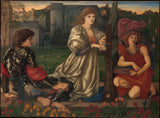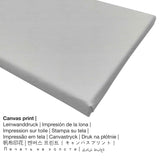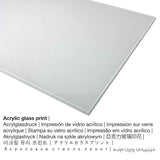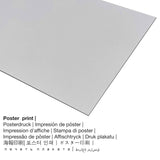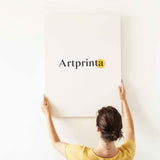Sir Edward Burne-Jones, 1868 - Abụ ịhụnanya - mbipụta nka mara mma
Ụtụ gụnyere. Mbupu gbakọrọ na ndenye ọpụpụ.
Ozi ngwaahịa nka dị omimi
a 19th narị afọ artwork named "The Love Song" was created by the painter Sir Edward Burne-Jones. The artwork measures the size: 45 x 61 3/8 in (114,3 x 155,9 cm) and was painted on the medium mmanụ na kwaaji. Taa, artpiece na-etolite akụkụ nke Ụlọ ihe ngosi nka nke Metropolitan nchịkọta dijitalụ. Site n'ikike nke Ụlọ ihe ngosi nka nke Metropolitan, New York, The Alfred N. Punnett Endowment Fund, 1947 (license: public domain). In addition to that, the artpiece has the following creditline: The Alfred N. Punnett Endowment Fund, 1947. Further, the alignment of the digital reproduction is in odida obodo format na akụkụ nke 4: 3, nke na-egosi na ogologo ya dị 33% ogologo karịa obosara.
Kedu ihe ga-abụ nhọrọ akụrụngwa kacha amasị gị?
Maka mbipụta nka ọ bụla anyị na-enye ụdị nha na ihe dị iche iche. Nha na ihe ndị a bụ nhọrọ anyị na-enye gị maka nkeonwe:
- Mpempe akwụkwọ ederede (akwa akwa akwa): A poster print is a UV printed sheet of cotton canvas paper with a granular surface structure. Please bear in mind, that depending on the size of the canvas poster print we add a white margin of something between 2-6cm around the painting, which facilitates the framing with your custom frame.
- Mbipụta iko acrylic na-egbuke egbuke (nke nwere ezigbo mkpuchi iko): The print on acrylic glass, which is sometimes labelled as a an art print on plexiglass, will change your favorite artwork into beautiful décor and is a distinct alternative option to canvas and dibond prints. Your own version of the work of art will be custom-made with state-of-the-art UV print technology. With an acrylic glass fine art print sharp contrasts and also small color details become recognizeable with the help of the very fine gradation of the print. The real glass coating protects your selected fine art print against light and heat for between 40-60 years.
- Mbipụta kanvas: A canvas print, which shall not be mistaken with a canvas painting, is a digital image printed from a UV direct printer. Your printed canvas of this artwork will provide you with the chance of transforming your fine art print into a large size artwork like you would see in a gallery. The advantage of canvas prints is that they are relatively low in weight. This means, it is easy to hang up your Canvas print without additional wall-mounts. Hence, a canvas print is suitable for all types of walls.
- Mbipụta nke aluminom: Aluminium Dibond prints are metal prints with an outstanding depth effect. The white & bright components of the original artwork shine with a silk gloss, however without glow. Colors are vivid and luminous, the fine details appear very clear, and the print has a a matte look you can literally feel. This direct print on Aluminum Dibond is one of the most demanded entry-level products and is an extremely contemporary way to showcase artworks, as it puts 100% of the viewer’s focus on the image.
Important note: We try our best to describe our products as closely as it is possible and to showcase them visually in our shop. Still, the colors of the print products and the imprint may vary marginally from the image on your screen. Depending on the settings of your screen and the nature of the surface, not all color pigments are printed as realistically as the digital version depicted here. Considering that all the art prints are processed and printed by hand, there might also be slight differences in the exact position and the size of the motif.
Ngwaahịa a
| Nkewa ngwaahịa: | nka nka |
| Usoro mmeputakwa: | mmeputakwa n'ụdị dijitalụ |
| Usoro mmepụta: | UV kpọmkwem obibi |
| Nlụpụta: | German mere |
| Ụdị ngwaahịa: | a na-achọ |
| A na-atụ aro iji ngwaahịa eme ihe: | art ebipụta gallery, mgbidi ịchọ mma |
| Ndozi onyonyo a: | nhazi odida obodo |
| Njikwa oyiyi: | 4: 3 (ogologo: obosara) |
| Nkọwa nke oke akụkụ: | ogologo bụ 33% ogologo karịa obosara |
| Nhọrọ ihe dị: | mbipụta ọla (aluminium dibond), mbipụta akwụkwọ mmado (akwụkwọ kwaaji), mbipụta kanvas, mbipụta iko acrylic (nwere ezigbo mkpuchi iko) |
| Mpempe akwa akwa (akwa akwa na etiti ihe ndọtị) nha: | 40x30cm - 16x12", 80x60cm - 31x24", 120x90cm - 47x35", 160x120cm - 63x47" |
| Mbipụta iko acrylic (nwere ezigbo mkpuchi iko) nhọrọ nha: | 40x30cm - 16x12", 80x60cm - 31x24", 120x90cm - 47x35", 160x120cm - 63x47" |
| Mbipụta akwụkwọ mmado (akwụkwọ kwaaji): | 40x30cm - 16x12", 80x60cm - 31x24", 120x90cm - 47x35" |
| Nha ebipụta aluminom: | 40x30cm - 16x12", 80x60cm - 31x24", 120x90cm - 47x35" |
| Nhazi mbipụta nka: | enweghị etiti |
Nkọwa ọrụ nka
| Aha ọrụ nka: | "The Love Song" |
| Nhazi nka: | sere |
| Otu izugbe: | nkà nke oge a |
| Century: | 19th narị afọ |
| Afọ okike: | 1868 |
| Afọ nka: | 150 afọ |
| Ihe osise izizi: | mmanụ na kwaaji |
| Nha izizi nka: | 45 x 61 3/8 na (114,3 x 155,9 cm) |
| Egosiputara na: | Museumlọ ihe ngosi nka nke Obodo |
| Ebe ngosi nka: | New York City, New York, Njikota Obodo Amerika |
| ibe weebụ: | Museumlọ ihe ngosi nka nke Obodo |
| Licensedị ikike: | ngalaba ọha |
| Site n'aka: | Ụlọ ihe ngosi nka nke Metropolitan, New York, The Alfred N. Punnett Endowment Fund, 1947 |
| Ebe E Si Nweta: | Ego enyemaka nke Alfred N. Punnett, 1947 |
Tebụl nyocha nke onye na-ese ihe
| Aha onye nka: | Sir Edward Burne-Jones |
| Gender: | nwoke |
| Obodo onye nka: | British |
| Ọrụ: | onye na-ese ihe |
| Mba onye si: | United Kingdom |
| nhazi ọkwa: | omenkà nke oge a |
| Ndụ: | 65 afọ |
| Afọ ọmụmụ: | 1833 |
| Nwụrụ n'afọ: | 1898 |
Nwebiisinka © | www.artprinta.com (Artprinta)
Ozi nka ndị ọzọ sitere na museum (© Nwebiisinka - The Metropolitan Museum of Art - www.metmuseum.org)
Burne-Jones associated this painting with a refrain from a Breton folk ballad: "Alas, I know a love song, / Sad or happy, each in turn." Drawing inspiration from the gothicizing Pre-Raphaelite movement, the artist conjured a twilight scene with a richly romantic, medieval air, enhanced by allusions to Italian Renaissance art, from the warm, dewy colors to the gracious figures and original frame, which recalls sixteenth-and-seventeenth-century Venetian designs. When the picture was first exhibited at the Grosvenor Gallery, London, in 1878, the novelist Henry James admiringly compared it to "some mellow Giorgione or some richly-glowing Titian."Listen to the song that inspired the painting.

